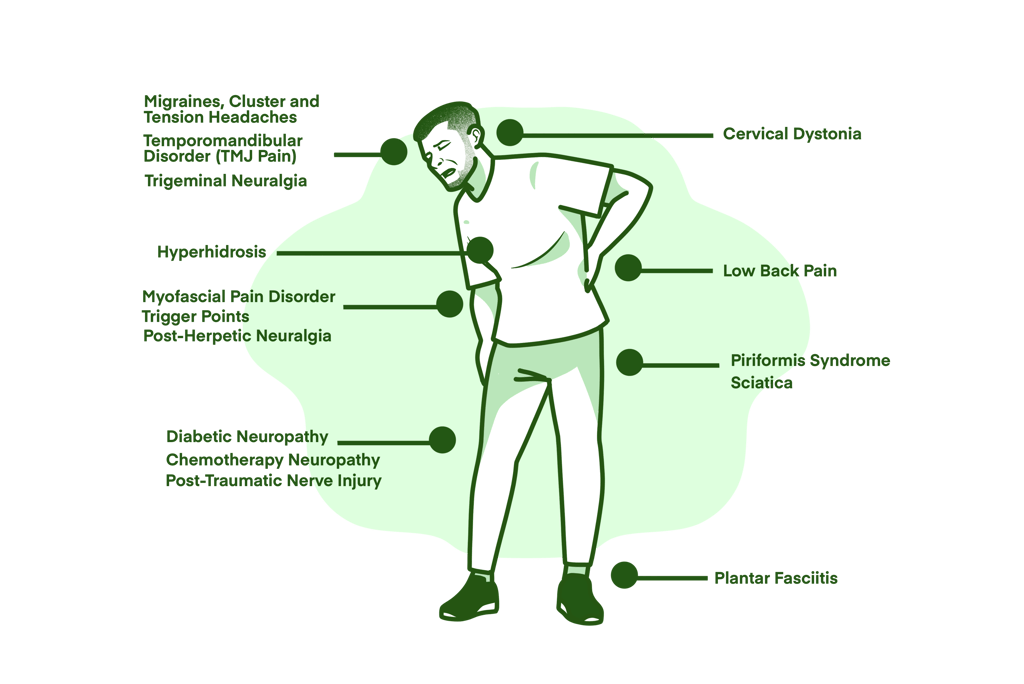What is Botox?
Botox®, short for botulinum toxin, is a neurotoxic protein produced by the bacterium Clostridium botulinum. Botox® is just one brand of Type A botulinum toxin; other brands include Nuceiva®, Xeomin®, and Dysport®. Botulinum toxin was first discovered in 1897, but it wasn’t until the 1970s that research by Dr. Alan Scott began to highlight its various medical applications. Today, botulinum toxin is used extensively for both medical and cosmetic purposes.
How Does Botox Treat Pain?
Botox is believed to alleviate pain through various mechanisms, including (1) modulation of pain pathways, (2) reduction in the sensitivity of pain receptors both centrally and peripherally, and (3) inhibition of acetylcholine release at the neuromuscular junction, resulting in a paralyzing effect on muscles. Medical research pioneered by Dr. Alan Scott initially explored the medical application of Botox in ophthalmology, specifically for treating strabismus and blepharospasm. Initially, Botox applications focused primarily on its muscle-paralyzing effects. However, in the 1990s, research began to show that Botox also affects central and peripheral pain transmission. Since then, Botox has been demonstrated to effectively treat numerous chronic pain conditions that are difficult to manage. Many treatment protocols have been developed at Walter Reed Medical Center in Washington, DC.
Here at the Toronto Botox Pain Centre, we have improved upon the protocols established at Walter Reed by incorporating image-guided injections to ensure correct placement and maximize pain relief for the conditions being treated.
What Pain Conditions Do We Treat?
At the Toronto Botox Pain Centre, we have established treatment protocols to address the following conditions. Our goals for treatment simple, (1) relieve your underlying debilitating pain, (2) reduce or eliminate the dependence on oral pain medications, and (3) help re-establish a healthy and active lifestyle to regain quality of life.
The conditions we treat at the Toronto Botox Pain Centre:
Neuropathic Pain Syndromes
Post-Herpetic Neuralgia (Shingles Pain)
Myofascial Pain Disorder
Trigger Points
Fibromyalgia
Neuropathic Pain
Diabetic Neuropathy
Chemotherapy-Induced Neuropathy
Post-Traumatic Nerve Injury Pain
Post-Stroke Nerve Pain
Pain syndromes Affect the Head
Chronic Migraines
Cluster and Tension Headaches
Trigeminal Neuralgia
Temporomandibular Disorder (TMJ Pain)
Musculoskeletal Pain Syndromes
Cervical Dystonia
Focal Muscle Spasticity
Chronic Low Back Pain
Piriformis Syndrome / Sciatica Pain
Plantar Fasciitis
Hyperhidrosis
Palmar Hyperhidrosis
Axillary Hyperhidrosis


Frequently asked questions
Are the treatments covered by OHIP?
All consultations and visits are covered by OHIP. The Treatments are not covered by OHIP and there is an associated fee.
How long does the pain relief last?
As with all medical treatments, the results can vary between patients but typically the effect of a successful treatment can provide pain relief for between 3-6 months.
How much do the treatments cost?
The cost varies depending if you have private insurance or qualify for either the Ontario Drug Benefit (ODB) or the Ontario Exceptional Access Program (EAP). With private insurance, ODB, or EAP the cost of the Botox can be fully or partially covered in which case only an Injection Fee would apply.
What does a treatment typically involve?
Botox treatments involve using small fine needles to place medication in specific treatment zones. Most injection sites are superficial and relatively painless. For deeper injections, local anesthetic will be used to reduce the sensation of the treatment. In addition, an Ultrasound may be used to ensure exact placement of Botox ensuring maximal relief.
Are there any financial assistance programs to help with cost?
Abbvie, the Canadian manufacturer and distributor of Botox has the Abbvie Care Financial Support Program, which can help offset the cost of Botox used for treatments. Please contact our office for more information.
How do I book an appointment?
We are accepting referrals from your physician, please click here to download a referral form. You can also Contact Us for more information.
250 Dundas Street West
Mississauga, Ontario. L5B 1J2
Phone: 647 - 550 - 5807
Fax: 647 - 697 - 8034


